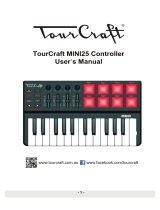
6
Connecting to a computer or MIDI devices
•
ToexchangeMIDImessageswithyourcomputer,connectyourcomputerto
theUSBBconnectoronthemonologue.
•
ToexchangeMIDImessageswithanexternalMIDIdevice,connectthede-
vicetotheMIDIIN/OUTconnectorsonthemonologue.
TIP
Fordetails,referto“UnderstandingMIDI”(p.51)
Connecting the SYNC IN and OUT jacks
•
UsetheSYNCINandOUTjacksofthemonologuewhenyouwanttosyn-
chronizetotheoutputpulsesandstepsfromtheaudiooutputjacksofsourc-
essuchastheKorgvolcaseriesoraDAW.ConnectusingaSynccable.
•
TheSYNCOUTjacksendsa5Vpulseof15msatthebeginningofeachstep.
TIP
Referto“Buon5(GLOBAL3)”(p.41)ofGLOBALEDITmodefor
theseingstoturnonthemonologue.
Turning the monologue On and O
Before you turn the monologue On:
Installing batteries
Makesurethatthemonologue’spoweristurnedo.
1.
Open the baery cover on the monologue’s boom panel.
Whilepressingthelatch,pullupwardandremove.
2.
Insert six AA baeries, taking care to observe the cor-
rect polarity (+/− orientation).
Usealkalineornickel-metalhydridebaeries.
3.
Reaach the baery cover.
Inorderfortheremainingbaeryamounttobedetectedandshown
correctly,youmustusetheparameterinGLOBALEDITmodeto
specifythetypeofbaeriesthatyou’reusing.Bydefault,thisseing
issetto“Alkaline.”Fordetails,referto“BaeryType”(p.43).
Whenthebaeriesbecomedepleted,“BaeryLow”willappearonthedis-
play.Whenthisoccurs,it’stimetoreplacethebaeries.
Removeoldbaeriesimmediately.Otherwise,baeryleakagemayoc-
cur,
resultinginamalfunction.Ifyoudon’tthinkthatyou’llbeusing
theunitforalongperiodoftime,youshouldremovethebaeries.
1





















